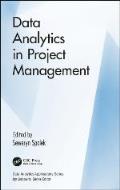BOOK REVIEW
 Book Title: Data Analytics in Project Management
Book Title: Data Analytics in Project Management
Edited by Seweryn Spalek
Publisher: CRC Press
List Price: $129.95
Format: Hard Cover, 221 pages
Publication Date: 2018
ISBN: 978-1-138-30728-5
Reviewer: Richard Gower, PMP
Review Date: June 2019
Introduction
Companies are managing increasing number of projects and these projects are generating extremely large amounts of data. Data Analytics in Project Management blends together the techniques and processes of data analysis with those of project management, providing value and insight for project managers, members of the project management office, and students of data analytics.
Overview of Book’s Structure
This book is a collection of 15 to 20-page essays related to both data analytics and project management and does a good job of introducing data analytics to those responsible for managing projects. The editor has done an excellent job of finding a collection of authors each well qualified in their individual areas and minimizing the overlap of topics between chapters. Each chapter is separate and can be read independent of other chapters.
The book starts with a look at why we should use data analytics with project management (spoiler alert: it yields superior project outcomes) and discusses combining business data analytics with project management metrics and identifies the value that data analytics provides to the key players in an organization. The different types of data analytics are presented, and the authors describe a future of analytics tracking trillions of data points in real time and using Artificial Intelligence to devise appropriate strategies.
The book continues with a look at the risks associated with data analytics projects and then moves to a discussion on the analytical challenges of the modern PMO. The concept of project knowledge management highlights the importance for companies to properly manage the information from the many projects and portfolios and demonstrates the role of the PMO as a multilevel data analysis center. The chapter on data analytics and project portfolio management describes the different levels of analysis and suggests a five-step methodology for conducting analytics.
Subsequent chapters explain Earned Value Management, discuss how to manage the challenges of big data in the project environment, provide an overview of IT solutions of data analytics in project management, and look at the approaches to mining data for better decision making. The book finishes up looking at data analytics in agile project management and the alignment of agile software development principles and CRISP-DM, a model that describes the stages used to tackle data mining problems, and the challenges of combining data analytics with Scrum.
Highlights
The book presents several different perspectives of data analytics within the framework of project management and the individual chapters provide the reader with a good introduction to both data analytics and project management. The topics are presented with an assumption that the reader has little or no background in each subject and the chapters build on the basics with examples and references to other books and papers for further information.
The book provides a good background into how data analytics has progressed over time, defines the differences between descriptive, predictive and prescriptive data analytics, and lists how each can be used. It stresses how informed decisions are important, that the right decisions aid in successful outcomes, whereas poor decisions can send project teams in the wrong decision or allow the continuation of unjustified projects. It also discusses the different causes of bad decisions and provides a strategy for improving decision making. There are also very good discussions on the impact of big data on projects and data analysis.
The section on Earned Value Management is one of the best I have read with a very easy-to-follow explanation of earned value and the various calculations together with how to set up for EVM on a project, the progress measurement methods and potential pitfalls. As the authors point out, the biggest mistake is not setting up the project correctly to begin with; EVM is seldom successful as an afterthought.
More…
To read entire Book Review, click here
About the Reviewer

Richard Gower
UK and Texas, USA
![]()
Richard Gower, PMP has worked in the software industry for over 30 years, specializing in software development, business intelligence and data analytics. His experience includes software development, business analysis, project management, and product development. He is a Project Management Professional and has a M.S in Data Analytics from the University of Texas San Antonio (UTSA). He is currently the VP of Technology for E.J. Ward.
Richard can be reached at https://www.linkedin.com/in/rchrdgwr/
Editor’s note: This book review was the result of a partnership between the publisher, PM World and the PMI Alamo Chapter. Authors and publishers offer the books to PM World; books are delivered to the PMI Alamo Chapter, where they are offered free to PMI members to review; book reviews are published in the PM World Journal and PM World Library. PMI Alamo Chapter members can keep the books as well as claim PDUs for PMP recertification when their reviews are published.
If you have read a good recently-published book related to managing programs, projects or teams of professionals, consider authoring a book review for publication in the PM World Journal. For our standard format or for more information, contact Editor@pmworldjournal.com or visit https://pmworldlibrary.net/book-review-program/
If you are an author or publisher of a project management-related book, and would like the book reviewed through this program, please contact Editor@pmworldjournal.com.









